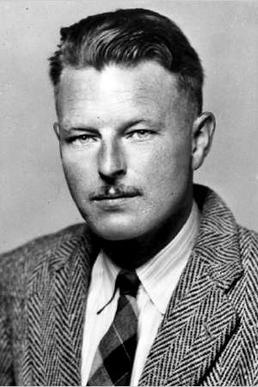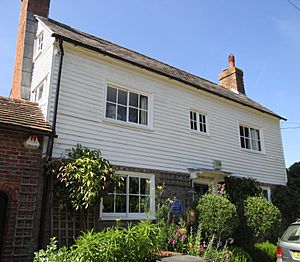Malcolm Lowry facts for kids
Quick facts for kids
Malcolm Lowry
|
|
|---|---|

Lowry in 1946
|
|
| Born | Clarence Malcolm Lowry 28 July 1909 New Brighton, England |
| Died | 26 June 1957 (aged 47) Ripe, England |
| Occupation | Novelist, poet |
| Literary movement | Modernism |
| Notable works |
|
| Spouse |
Jan Gabrial
(m. 1934; div. 1937)Margerie Bonner
(m. 1940) |
Clarence Malcolm Lowry (/ˈlaʊri/; 28 July 1909 – 26 June 1957) was an English poet and novelist who is best known for his 1947 novel Under the Volcano, which was voted No. 11 in the Modern Library 100 Best Novels list.
Contents
Biography
Early years in England
Lowry was born in New Brighton, Wirral, the fourth son of Evelyn Boden and Arthur Lowry, a cotton broker with roots in Cumberland. In 1912, the family moved to Caldy, on another part of the Wirral peninsula. Their home was a mock Tudor estate on two acres with a tennis court, small golf course and a maid, a cook and a nanny. Lowry was said to have felt neglected by his mother, and was closest to his brother.
In his teens Lowry was a boarder at The Leys School in Cambridge, the school made famous by the novel Goodbye, Mr. Chips. At age 15, he won the junior golf championship at the Royal Liverpool Golf Club, Hoylake. His father expected him to go to Cambridge and enter the family business, but Malcolm wanted to experience the world and convinced his father to let him work as a deckhand on a tramp steamer to the Far East. In May 1927, his parents drove him to the Liverpool waterfront and, while the local press watched, waved goodbye as he set sail on the freighter S.S. Pyrrhus. The five months at sea gave him stories to incorporate into his first novel, Ultramarine.
After returning to Britain Lowry enrolled at St Catharine's College, Cambridge in autumn 1929, in an attempt to placate his parents. He spent little time at the university, but excelled in writing, graduating in 1931 with a 3rd class honours degree in English. Lowry was already well travelled; besides his sailing experience, between terms he made visits to America, to befriend his literary idol, Conrad Aiken, and to Germany.
After Cambridge, Lowry lived briefly in London, existing on the fringes of the vibrant Thirties literary scene and meeting Dylan Thomas. He met his first wife, Jan Gabrial, in Spain. They were married in France in 1934. Theirs was a turbulent union, especially due to his drinking, and because she resented homosexuals attracted to her husband.
United States, Mexico, Canada
After an estrangement, Lowry followed Jan to New York City where he checked into Bellevue Psychiatric Hospital in 1936 – experiences which later became the basis of his novella Lunar Caustic. When the authorities began to take notice of him, he fled to avoid deportation and then went to Hollywood, where he tried screenwriting. At about that time he began writing Under the Volcano. Lowry and Jan moved to Mexico, arriving in the city of Cuernavaca on 2 November 1936, the Day of the Dead, in a final attempt to salvage their marriage.
The effort to save their marriage failed. She then ran off with another man in late 1937. Lowry was deported from Mexico in the summer of 1938. His family put him up at the Hotel Normandie in Los Angeles where he continued working on his novel and met his second wife, the actress and writer Margerie Bonner. His father sent his rent checks directly to the Normandie's hotel manager.
In August Lowry moved to Vancouver, British Columbia, Canada, leaving his manuscript behind. Later, Margerie moved up to Vancouver, bringing his manuscript, and the following year they married. At first, they lived in an attic apartment in the city. When World War II broke out, Lowry tried to enlist but was rejected. Correspondence between Lowry and Canada's Governor-General Lord Tweedsmuir (who was better known as the writer John Buchan) during this time resulted in Lowry's writing several articles for the Vancouver Province newspaper. The couple lived and wrote in a squatter's shack on the beach near the community of Dollarton, North Vancouver, north of Vancouver. In 1944, the beach shack was destroyed by a fire, and Lowry was injured in his efforts to save manuscripts. Margerie was an entirely positive influence, editing Lowry's work skillfully and making sure that he ate well. The couple traveled to Europe, America and the Caribbean, and this seems to have been a relatively peaceful and productive period. It lasted until 1954, when a final nomadic period ensued, embracing New York, London and other places.
He lived in Canada for much of his active writing career and is thus also considered a significant figure in Canadian literature. He won the Governor General's Award for English-language fiction in 1961 for his posthumous collection Hear Us O Lord from Heaven Thy Dwelling Place.
Death
Lowry died in June 1957, in a rented cottage in the village of Ripe, Sussex, where he was living with wife Margerie after having returned to England in 1955, ill and impoverished.
Lowry is buried in the churchyard of St John the Baptist in Ripe. Lowry reputedly wrote his own epitaph: "Here lies Malcolm Lowry, late of the Bowery, whose prose was flowery, and often glowery. He lived nightly, and drank daily, and died playing the ukulele," but the epitaph does not appear on his gravestone.
Legacy
In 2017 the British Library acquired Malcolm Lowry papers from his first wife Jan Gabrial. Lowry's literary papers had been left in the possession of Gabrial's mother, Emily Vanderheim, in 1936 and passed to Gabrial on her mother's death. Some further items were then acquired from Priscilla Bonner, the sister of Margerie Bonner Lowry. The archive contains literary papers of Lowry; personal papers of Jan Gabrial, primarily relating to her marriage to Lowry; and select items relating to Margerie Bonner Lowry, Lowry's second wife.
Writings
Lowry published little during his lifetime, in comparison with the extensive collection of unfinished manuscripts he left. Of his two novels, Under the Volcano (1947) is now widely accepted as his masterpiece and one of the great works of the 20th century (number 11 on the Modern Library's 100 Best Novels of the 20th century).
Ultramarine (1933), written while Lowry was still an undergraduate, follows a young man's first sea voyage and his determination to gain the crew's acceptance.
A collection of short stories, Hear Us, O Lord from Heaven Thy Dwelling Place (1961), was published after Lowry's death. The scholar and poet Earle Birney edited Selected Poems of Malcolm Lowry (1962). Birney also collaborated with Lowry's widow in editing the novella Lunar Caustic (1968) for re-publication. It is a conflation of several earlier pieces concerned with Bellevue Hospital, which Lowry was in the process of rewriting as a complete novel. With Douglas Day, Lowry's first biographer, Lowry's widow also completed and edited the novels Dark as the Grave Wherein my Friend Is Laid (1968) and October Ferry to Gabriola (1970) from Lowry's manuscripts.
The Selected Letters of Malcolm Lowry, edited by his widow and Harvey Breit, was released in 1965, followed in 1995–96 by the two-volume Sursum Corda! The Collected Letters of Malcolm Lowry, edited by Sherrill E. Grace. Scholarly editions of Lowry's final work in progress, La Mordida ("The Bribe"), and his screen adaptation of F. Scott Fitzgerald's Tender Is the Night have also been published.
Volcano: An Inquiry into the Life and Death of Malcolm Lowry (1976) is an Oscar-nominated National Film Board of Canada documentary directed by Donald Brittain and John Kramer. It opens with the inquest into Lowry's "death by misadventure", and then moves back in time to trace the writer's life. Selections from Lowry's novel are read by Richard Burton amid images shot in Mexico, the United States, Canada and England.
In 2001, Lowry's first wife Jan Gabrial revealed in her memoir that she had an early draft of Lowry's novel In Ballast to the White Sea, which was thought to have been lost. According to Professor Dean Irvine at Dalhousie University, Lowry had given an early copy of the novel to Gabrial's mother before the couple went to Mexico in 1936. Lowry's working copy of the manuscript was then lost in a fire. In October 2014 it was published for the first time by University of Ottawa Press and a launch was held at the Bluecoat Arts Centre in Liverpool.
The Voyage That Never Ends
Lowry envisioned The Voyage That Never Ends as his magnum opus: an epic cycle encompassing his existing novels and stories as well as projected works, with Under the Volcano as its centrepiece. He spent much of his writing life crafting his body of work into a greater, thematically cohesive whole, which he called The Voyage That Never Ends. It was to rival the epics of other great modernists, and he referred to it in several personal annotations and letters as the concept evolved over many years and works-in-progress.
His plans for The Voyage That Never Ends ultimately grew into a 34-page outline that he gave to the editor Albert Erskine, with whom he was friends. Lowry's early death, however, prevented him from finishing his grand project. Because so much of The Voyage That Never Ends was left incomplete (much of it hardly begun, barely going beyond his initial conceptual framework) what exists only hints at the final form Lowry intended for his magnum opus.
Works
- Ultramarine (1933), novel; published by Jonathan Cape
- Under the Volcano (1947), novel; made into a film by John Huston in 1984
Posthumous
- Hear Us O Lord from Heaven Thy Dwelling Place (1961), short story collection
- Selected Poems of Malcolm Lowry (1962)
- Lunar Caustic (1963), novella, French language edition preceding by five years the English edition
- Lunar Caustic (1968), novella
- Dark as the Grave Wherein My Friend Is Laid (1968), novel
- October Ferry to Gabriola (1970), novel
- The Cinema of Malcolm Lowry: A Scholarly Edition of Malcolm Lowry's "Tender is the Night" edited by Miquel Mota & Paul Tiessen (1990)
- The 1940 Under The Volcano (1994), novel
- La Mordida edited by Patrick A. McCarthy (1996), novel
- In Ballast to the White Sea (2014), novel; Edited by Patrick A. McCarthy, Notes by Chris Ackerley, Foreword by Vik Doyen, University of Ottawa Press, ISBN: 978-0-7766-2208-8
- Selected Poems of Malcolm Lowry -City Lights Publishers (2017) ISBN: 9780872867291
See also
 In Spanish: Malcolm Lowry para niños
In Spanish: Malcolm Lowry para niños



